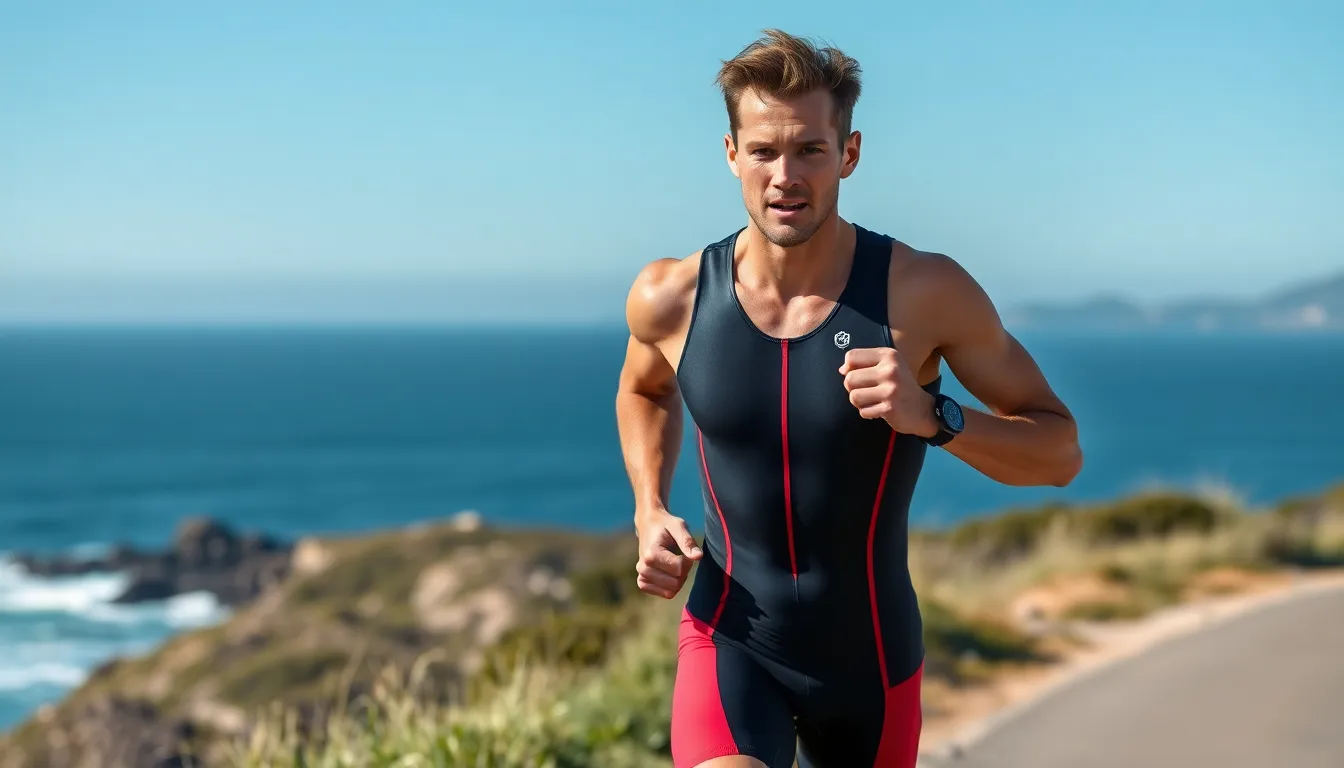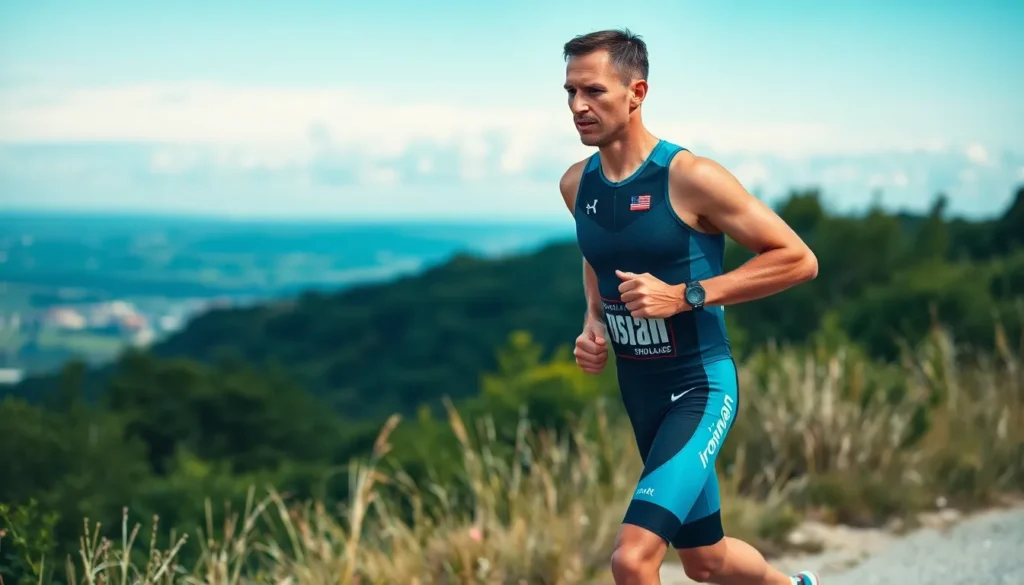For those ready to trade their couch for a racing seat, the Ironman Challenge is the ultimate test of endurance. Imagine swimming, biking, and running your way to glory—all while trying not to lose your lunch. It’s not just a race; it’s a rite of passage that separates the weekend warriors from the true athletes.
Table of Contents
ToggleOverview of Ironman Challenge Builds
Ironman Challenge builds represent a comprehensive training plan that focuses on the three disciplines: swimming, biking, and running. Each discipline requires specific endurance and strength adaptations, contributing to overall performance. The training builds typically vary based on athletes’ experience levels, offering tailored approaches for beginners and seasoned competitors alike.
Participants often adopt a periodized training schedule to enhance performance progressively. This schedule breaks down the training into phases, focusing on endurance, strength, and tapering periods. Specific workouts within these phases include long-distance runs, interval training for swimming, and hill repeats for cycling.
Nutrition plays an essential role in Ironman builds. Athletes need to fuel their bodies with appropriate carbohydrates, proteins, and healthy fats to optimize endurance and recovery. Maintaining hydration during workouts also helps sustain performance levels across training sessions.
Supplementary training often forms part of many Ironman Challenge builds. Strength training, flexibility exercises, and cross-training help prevent injuries while enhancing overall fitness. Incorporating yoga or Pilates can improve flexibility and core strength, which benefits performance in all three disciplines.
Tracking progress remains crucial throughout the training. Athletes frequently keep logs detailing their workouts, nutrition, and recovery strategies. Regular assessments help identify strengths and weaknesses, guiding subsequent training adjustments.
An effective Ironman Challenge build encompasses a balanced approach to training, nutrition, and supplementary exercises. Adopting this comprehensive strategy helps athletes maximize their potential in the intense and demanding event that is the Ironman.
Types of Ironman Challenge Builds

Ironman Challenge builds vary to accommodate different experience levels, ensuring athletes optimize their training effectively. The two main types are beginner builds and advanced builds, each tailored to specific needs.
Beginner Builds
Beginner builds focus on foundational skills and ensuring a gradual progression. Athletes often start with shorter distances in each discipline, gradually increasing duration. Structured schedules typically incorporate three to four training sessions per week, emphasizing consistency. Key workouts frequently include steady-paced runs, easy bike rides, and basic swim drills. Nutritional guidance centers on maintaining energy levels and hydration, helping beginners adapt without overwhelming their bodies. Regular assessments ensure that participants monitor their progress and make adjustments as needed.
Advanced Builds
Advanced builds target seasoned athletes seeking to enhance their performance and maximize speed. Training plans usually involve five to six workouts weekly, with more intense sessions like tempo runs, interval swims, and hill repeats for cycling. Athletes may incorporate strength training to improve power and endurance. Nutrition plays a critical role in recovery and performance, focusing on optimizing nutrient timing and hydration strategies. Comprehensive effort tracking, including heart rate and pace monitoring, aids in refining their approach. Tailored adjustments based on performance metrics help athletes reach their peak potential during competition.
Essential Gear for Ironman Challenge Builds
Selecting the right gear significantly impacts performance and comfort during the Ironman Challenge. Athletes rely on a combination of specialized equipment tailored to each discipline.
Recommended Equipment
Swimmers benefit from a quality wetsuit, which enhances buoyancy and insulation. Bicyclists need a lightweight road bike equipped with aerodynamic handlebars and clipless pedals for optimal efficiency. Runners prefer comfortable shoes designed for long distances, offering adequate support and cushioning. Hydration packs or belts keep athletes hydrated throughout their training and races. GPS watches provide essential data on pace and distance, helping track progress effectively.
Importance of Quality Gear
Quality gear plays a vital role in athlete performance and recovery. A well-fitted wetsuit, for example, minimizes drag and maximizes speed in the water. Reliable bikes and shoes prevent injuries by ensuring proper support during intense workouts. Investing in gear from reputable brands assures durability and enhances overall experience. When athletes use high-quality equipment, they gain confidence and focus on their performance instead of equipment failures. Proper gear selection also contributes to an athlete’s motivation, encouraging consistent training as they prepare for the challenge ahead.
Strategies for Successful Ironman Challenge Builds
Successful Ironman Challenge builds rely on meticulous planning and effective training techniques. Following a structured approach ensures athletes maximize their training outcomes.
Planning Your Build
Planning an Ironman Challenge build starts with setting clear goals. Athletes should assess their current fitness levels and establish both short-term and long-term objectives. Construct a detailed training schedule that encompasses swimming, biking, and running. Allocate recovery periods, as rest is vital for performance improvement. Tracking progress through weekly assessments allows for a better understanding of strengths. Identifying weaknesses early on facilitates necessary adjustments in the training plan.
Training Techniques
Training techniques for Ironman builds focus on a balanced approach to all three disciplines. Incorporating variety in workouts enhances endurance and skill. Long-distance runs solidify aerobic capacity, while interval training boosts speed and power in swimming. Cycling sessions should include hill repeats to build strength. Implement functional strength training to prevent injuries and improve overall fitness. Consistency is key; athletes should strive for regular training sessions that gradually increase in intensity and volume.
Common Mistakes to Avoid
Choosing inadequate gear can hinder performance during the Ironman Challenge. Athletes must select quality wetsuits, lightweight bikes, and comfortable shoes to support their training effectively. Neglecting nutrition leads to energy depletion and suboptimal recovery. It’s crucial to maintain a balanced diet rich in carbohydrates, proteins, and healthy fats.
Overtraining is another common pitfall. Athletes should prioritize recovery periods in their training schedules to enhance performance and prevent burnout. Focusing solely on one discipline, such as swimming or cycling, often results in imbalances. A well-rounded training plan should devote equal attention to swimming, biking, and running.
Not tracking progress can obscure insights into performance. Regular assessments and workout logs help athletes identify strengths and weaknesses, allowing necessary adjustments. Setting vague goals often leads to confusion and lack of direction; athletes need clear, measurable objectives to maintain focus.
Skipping flexibility and strength training can increase injury risk. Supplementary exercises are important to enhance overall fitness, providing stability and resilience. Ignoring hydration contributes to fatigue and affects performance on race day. Athletes are reminded to drink water or electrolyte-replenishing beverages consistently.
Lastly, inconsistency disrupts training progress. Establishing a routine with regular workouts supports gradual improvement. Finding accountability, whether through training partners or coaches, helps maintain motivation. To excel in the Ironman Challenge, avoiding these common mistakes is essential for optimal performance and a successful experience.
The Ironman Challenge demands dedication and strategic planning. Athletes must approach their training with a clear understanding of their goals and the necessary steps to achieve them. By following tailored builds that cater to their experience levels they can enhance their performance across swimming, biking, and running.
Nutrition and proper gear play vital roles in ensuring success. With the right fuel and equipment athletes can optimize their training and recovery. Staying mindful of common pitfalls can help maintain progress and prevent setbacks.
Ultimately the journey through an Ironman Challenge is as rewarding as it is demanding. With commitment and the right strategies in place athletes can rise to the occasion and achieve their personal best.





